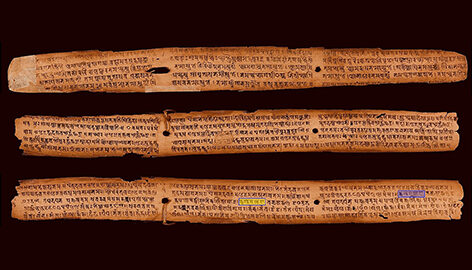

Sanskrit Language Origin: Sanskrit language history is one of the three earliest ancient, documented languages that can be traced from the Proto-Indo-European language. It belongs to the Indo-European family of languages.
The term ‘Sanskrit’ can be divided into ‘sam’ which meant together, good, well, or perfected and ‘Krta’ means made, formed, or work. The Sanskrit language origin date is as old as Vedic literature.
Sanskrit Grammar: Phonology & Vowels:
The language shares many Proto-Indo-European phonological features. The most significant and distinctive phonological development in Sanskrit is vowel-merger. The cardinal vowels (svaras) distinguish length in Sanskrit. The Sanskrit vowels are inherently long, though often transcribed e and o without the diacritic.
The oldest surviving Sanskrit palm-leaf manuscripts were discovered in 828 CE. It was found in Nepal; the bottom leaf shows all the vowels and consonants of Sanskrit.
As Sanskrit language history is not anyone’s native language, it does not have a fixed pronunciation. People tend to pronounce it as they do in their native language. The articles on Hindustani, Marathi, Nepali, Oriya, and Bengali phonology will give some indication of the variation that is encountered. When Sanskrit was spoken in ancient times, its pronunciation varied regionally and over time. Panini also described the sound system of Sanskrit language history.
Ramayana & Mahabharata Stamp:
The Mahabharata is one of the two major Sanskrit epics of ancient India. It narrates the war between the Kaurava and the Pāṇḍava princes which also happened to be cousins.
It is not justified to call is as a just poem but it should be seen as a whole body of literature in its own right. Its longest version consists of over 100,000 sloka or over 200,000 individual verse lines and long prose passages. The Mahabharata is roughly ten times the length of the Iliad and the Odyssey combined or about four times the length of the Ramayaṇa. This piece of Sanskrit language history has an enormous mass of poetry, myths and legends, secondary tales, moral stories, and much more get appended over the centuries written in 18 books along with the last Harivamsa book.
India Post issued a miniature sheet on the theme of Mahabharata on 27th November 2017.
Ramayana consists of only 24,000 slokas divided into seven books, the first and the seventh being later additions. It is more purely regular, ornate epic poetry, a form of style which is the basis of the later Kavya tradition.
There are 2 parts of the Ramayana story that are narrated in the 5 books. The first story revolves around the events at the court of King Dasaratha at Ayodhya. In this, one of his wives vying for the succession of the throne to her own son Bharata in place of the one chosen by the king, Rama.
The second part is about banished Rama combating giants in the forest, slaying thousands of demons, and so on. Last part of the second deals with the abduction of Rama’s wife, Sita by king Ravaṇa of Lanka. And after the climax, Rama carries out to expedition to the island to defeat the king in battle and recover his wife.
India Post released a Ramayan postage stamp on 22nd September 2017 which consisted of 11 special postage stamps depicting important instances of Ramayana. You can buy miniature sheets online of Ramayana and Mahabharata too.
Kalidasa Stamp:
Secular literature is full of alliteration, similes, metaphors, and other figures of speech. The oldest surviving example of Kavya literature is Buddhacarita written by the Buddhist poet and philosopher Asvaghosa.
The old Indian stamps of Kalidasa were issued in the year of 1960. The old Indian stamp bears as theme the following Sanskrit verse from the Meghaduta.
Kalidasa ancient India’s wizard is also popularly known as Shakespeare of India. He is said to have been the finest master of the Sanskrit poetic style. Arthur Macdonell quoted about him, “firmness and evenness of sound, avoiding harsh transitions and preferring gentle harmonies; the use of words in their ordinary sense and clearness of meaning; the power to convey sentiment; beauty, elevation, and the employment of metaphorical expressions.”
It is chronicles of Ram’s life alongside his forefathers and successors. The Raghuvamsa is seen to meet all the criteria of a maha kavya, such as that the central figure should be noble and clever, and triumphant, and those works have rasa and bhava, and so on. There are more than 20 commentaries of this work that are known today.
Kalidasa narrates the story of the courtship and wedding of the god Siva and Parvati, Himalaya’s daughter, and the birth of their son, Kumara. This showcases the poet’s rich and original imaginative powers making for abundant poetic imagery and wealth of illustration. 20 commentaries on the Kumāra·sambhava have survived so far.
Panini Grammatical Works:
By the time Sutra was created, the language had evolved sufficiently. The older literature was difficult to understand and to recite correctly.
Panini was a Sanskrit grammarian and scholar in ancient India. He has been considered the first descriptive linguist and also called the father of linguistics and is an indispensable element of Sanskrit language history.
The Pratisakhya Sutras deals with accentuation, pronunciation, prosody, and related matters in order to study the phonetic changes that have taken place in Vedic words.
The Mintage World Team comprises of experts, researchers and writers from the field of Philately, Notaphily and Numismatics who try to shed light on some of the most interesting aspects of coins, banknotes and stamps from not just India but across the globe as well.